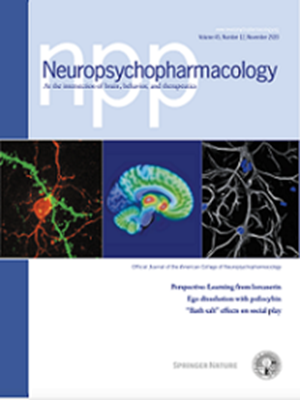REM density predicts rapid antidepressant response to ketamine in individuals with treatment-resistant depression
IF 6.6
1区 医学
Q1 NEUROSCIENCES
引用次数: 0
Abstract
Abnormalities during rapid eye movement (REM) sleep contribute to the pathophysiology of major depressive disorder (MDD), but few studies have explored the relationship between REM sleep and treatment-resistant depression (TRD). In MDD, REM sleep abnormalities often manifest as alterations in total night REM Density (RD), RD in the first REM period (RD1), and REM Latency (RL). Among these, RD1 is notably considered a potential endophenotype of depression. This study compared REM sleep markers between 63 drug-free individuals with TRD (39 F/24 M) and 41 healthy volunteers (25 F/16 M). It also investigated the effects of ketamine, an N-methyl-D-aspartate (NMDA) receptor antagonist, on these REM sleep variables. Specifically, the study investigated whether RD1 could predict antidepressant response to ketamine. TRD participants showed higher RD1 and shorter RL at baseline compared to HVs, as assessed via non-parametric tests, but Total Night RD did not differ between the two groups. Ketamine treatment decreased RD1 in TRD participants but did not affect Total Night RD or RL. As assessed via the Support Vector Machine (SVM) algorithm, baseline RD1 level moderately predicted antidepressant response to ketamine versus non-response (area under the receiver operating characteristic (ROC) curve (AUC) = 0.73, with a median accuracy of 0.75), wherein TRD participants with higher baseline RD1 were more likely to respond to ketamine. These results underscore the utility of RD1 for identifying individuals most likely to benefit from ketamine treatment, enabling more targeted and effective therapeutic strategies. Clinical Trials Identifier: NCT00088699, NCT01204918.

快速眼动密度预测治疗难治性抑郁症患者对氯胺酮的快速抗抑郁反应。
快速眼动(REM)睡眠异常有助于重度抑郁症(MDD)的病理生理,但很少有研究探讨REM睡眠与难治性抑郁症(TRD)之间的关系。在重度抑郁症中,REM睡眠异常通常表现为夜间REM总密度(RD)、第一REM期REM密度(RD1)和REM潜伏期(RL)的改变。其中,RD1被认为是抑郁症的潜在内表型。本研究比较了63名无药物TRD患者(39 F/24 M)和41名健康志愿者(25 F/16 M)的快速眼动睡眠指标。它还研究了氯胺酮(一种n -甲基- d -天冬氨酸(NMDA)受体拮抗剂)对这些快速眼动睡眠变量的影响。具体来说,该研究调查了RD1是否可以预测氯胺酮的抗抑郁反应。通过非参数测试评估,与HVs相比,TRD参与者在基线时表现出更高的RD1和更短的RL,但两组之间的总夜间RD没有差异。氯胺酮治疗降低了TRD参与者的RD1,但不影响总夜RD或RL。通过支持向量机(SVM)算法评估,基线RD1水平适度预测氯胺酮与无反应的抗抑郁反应(受试者工作特征(ROC)曲线下面积(AUC) = 0.73,中位准确度为0.75),其中基线RD1较高的TRD参与者更有可能对氯胺酮产生反应。这些结果强调了RD1在识别最有可能从氯胺酮治疗中受益的个体方面的效用,从而实现更有针对性和更有效的治疗策略。临床试验编号:NCT00088699, NCT01204918。
本文章由计算机程序翻译,如有差异,请以英文原文为准。
求助全文
约1分钟内获得全文
求助全文
来源期刊

Neuropsychopharmacology
医学-精神病学
CiteScore
15.00
自引率
2.60%
发文量
240
审稿时长
2 months
期刊介绍:
Neuropsychopharmacology is a reputable international scientific journal that serves as the official publication of the American College of Neuropsychopharmacology (ACNP). The journal's primary focus is on research that enhances our knowledge of the brain and behavior, with a particular emphasis on the molecular, cellular, physiological, and psychological aspects of substances that affect the central nervous system (CNS). It also aims to identify new molecular targets for the development of future drugs.
The journal prioritizes original research reports, but it also welcomes mini-reviews and perspectives, which are often solicited by the editorial office. These types of articles provide valuable insights and syntheses of current research trends and future directions in the field of neuroscience and pharmacology.
 求助内容:
求助内容: 应助结果提醒方式:
应助结果提醒方式:


